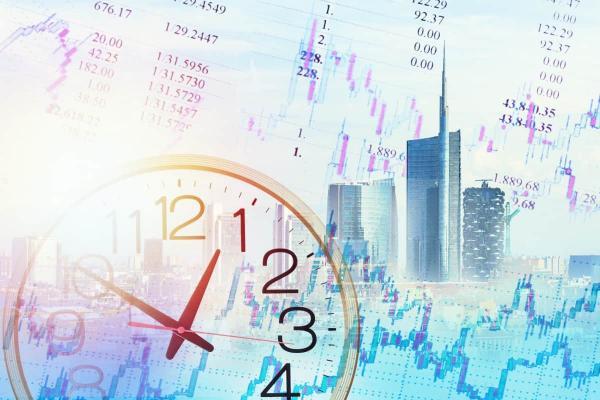

Forex Market Hours
Forex Market Hours Definition
The foreign exchange market consists of banks, large organisations, asset management companies, hedge funds, retail brokers and investors worldwide. The market hours offer them a timetable that indicates when they can conduct currency operations and when they can't.
The market hours offer a timetable for when currency operations can be conducted and when they can't.
Technically, sessions are restricted to business hours like typical stock exchange hours but considering there are multiple markets worldwide; forex can be entered at any time. When one session ends, another one is already in full swing. It only stops for weekend breaks and holidays. However, with the moving time zones, weekends are squeezed tighter.
Forex can be entered at any time of day during the workweek.
Forex accommodates many markets with trading hours dictated by when trading opens in different parts of the world.
Why Forex Market Hours Are So Important

Currency pairs are open to trading whenever you wish, but no trader or investor can keep an eye on the market or a position for hours on end. Moreover, not all market hours offer possibilities.
Certain currency pairs demonstrate different trends and activities as you move throughout the day. It's because market participants belong to varying demographic groups and engage during different parts of the day. This concludes that the most profitable activity is closely connected to certain busy market hours.
The most profitable activity is closely connected to certain busy market hours.
For instance, if a forex trader is unaware of what to expect from a session, they might miss a profitable opportunity. Or the trader might not be at their computer when there's a spike in volatility, allowing them to move against a set position (please bear in mind that market volatility affords traders the ability to make or lose money). To minimise the risk, you can learn the most common volatility patterns and choose what time fits your personal trading needs.
You can learn the most common volatility patterns and choose what time fits your trading style.
Major Forex Trading Sessions
Major sessions and the most influential financial centres go together. The session bears the title of the relevant city during its business hours. Generally, forex is divided into sessions according to which ones are associated with peak traction.
Asian Session (Tokyo)
When an optimal liquidity position is restored from the weekend break, the Asian trading session appropriately sees the results of that first. This is where the trading week effectively starts. The Tokyo financial markets unofficially define the trend for this region.
Tokyo works from 7:00 pm to 4:00 am EST (EDT).
Nevertheless, this session isn't restricted by Tokyo alone and attracts movement from other places. Given that the Australian, Chinese and Russian markets are so geographically distant, there are good reasons for the beginning and the ending Asian market hours to go further than the regular Tokyo hours. Minor fluctuations are because Asian economies are highly dependent on the export of their goods, and therefore they don't need strong fluctuations in national currencies.
Asian economies are highly dependent on the export of their goods, and therefore they don't need strong fluctuations in national currencies.
European Session (London)
As the trading day advances, not long before the Asian session closes its doors, the European session steps in. This particular area is crammed with multiple markets, so this zone is notably busy due to some leading European financial markets. London takes on the role of dictating the parameters for the European session, which accounts for 30% of all forex operations.
London works from 3:00 am to 12:00 noon EST (EDT).
The European market is an interesting field since there are many influential platforms, such as France and Germany. They start operating even before the official start in the UK. At the time of its opening, the euro grows in price, and the market sees a strong price movement.
Such a situation is ideal for obtaining high profits, but this can only be achieved by experienced players who can monitor the fluctuations of many currencies and make a quick forecast regarding market trends. The session is extended to use the volatility generated by the London market.
There is strong price movement in the market, which is ideal for obtaining high profits.
US session (New York)
By the time the American market opens, the Asian session has already closed. Nevertheless, the European participants have only had half of the working day. For the most part, the US session is naturally determined by what is happening in the States, with some influence coming from Canada, Mexico and a few other participants.
New York works from 8:00 am to 5:00 pm EST (EDT).
Unsurprisingly, the active state of the market in New York signifies intense volatility. If a news release directly relates to the region, it always causes a strong reaction and a very sharp change in exchange rates. This market is peculiar because it creates big price changes in seconds.
The New York session signifies intense volatility and creates the strongest price change in seconds.
The US session's beginning at 8:00 am is the unofficial start prompted by the early work of the futures exchange, commodity market and the noticeable inflow of economic and political news. As a result of the difference between the market closing time in one part of the world and a new trading day in another, a gap in liquidity takes place at 5:00 pm when the New York market closes.
Minor Forex Trading Sessions
Early Monday morning, New Zealand comes into play with the Wellington market, and it technically indicates the start of the new week.
Wellington works from 5:00 pm to 1:00 am EST (EDT).
Wellington is very calm and observes a rather small turnover. Because of this, it's not considered a very popular platform.
Sydney
Another market in the Pacific area is Sydney. Its activity only begins to gain momentum with this session because the real movement starts with the Tokyo session in two hours.
Sydney works from 5:00 pm to 2:00 am EST (EDT).
Hong Kong/Singapore
The Hong Kong and Singapore exchanges open an hour after Tokyo, and the movement is seen in pairs such as the Japanese yen, CNY, the Hong Kong and Singapore dollar.
Hong Kong and Singapore work from 8:00 pm to 5:00 am EST (EDT).
8:00 - 8:30 pm is generally a post-news off-peak period, which lasts a couple of hours. The trading volume increases towards the end.
Frankfurt
The amount of conversion operations in Frankfurt is significant. The operations are simultaneously carried out in London, Frankfurt, and partly in New York, so it's great for conducting large-scale operations.
Frankfurt works from 2:00 am to 11:00 am EST (EDT).
Chicago
The majority of Chicago banks open an hour later than in New York.
Chicago works from 9:00 am to 6:00 pm EST (EDT).
The exchange time of the International Monetary Market (IMM) - a division of the Chicago Mercantile Exchange, CME - is 07:20 am and 2:00 pm. The trading in currency futures is heavily conducted at IMM, which strongly impacts exchange rates.
Overlaps in Forex Trading Sessions

Overlaps correspond to bigger price movements, leading to favourable circumstances. Three overlaps take place every day:
- Frankfurt and Tokyo (2:00 am to 4:00 am): there's a much smaller volatility movement than the New York/London overlap. However, there are still moderate fluctuations for you to use. EUR/JPY is the better combination to go for, as they are most affected.
- London and Tokyo (3:00 am to 4:00 am): the profit opportunities can be seen in currencies that are in high demand, such as the yen, euro and pound. Since the US market has yet to open, this overlap has moderate pip changes.
- New York and London (8:00 am to noon): the central time for the day, i.e. the most intense and fruitful period. Since more than 70% of all FX operations are carried out at this overlap, it's proof that high volatility brings greater profits. This has to do with the fact the US dollar, euro and pound gain the biggest traction.
When Is the Best Time to Trade?
The most volatile periods for conducting FX operations are the busiest periods, such as London and New York sessions. This implies large operation volumes, so take a look at whether your currency pair is in high demand. It also means sharp price changes, but keeping up with changing trends requires some experience. This is common for the busiest sessions and their overlaps. Also, the spreads get narrower, and this leads to lower fees.
The most volatile period is when the market is the busiest such as the London and New York sessions.
The broadly acceptable principle is that Tuesday, Wednesday and Thursday attract the biggest activity. In case you want to limit your workweek, these three days would be the best choice.
That said, there are serious grounds for acting cautiously. If a trader wants to have tremendous profit, they might be tempted to use leverage as high as 1000:1. While this ratio could potentially provide large gains, on the flip side, the trader risks losing equally large sums of money because of one trade.
However, a trader risks losing large sums of money because of one trade.
For example, you could be working with the EUR/USD currency pair. With the influence of busy traction, the New York/London session overlap could possibly yield the highest profits for you. Similarly, depending on what pair you're aiming to work with, research when the peak activity takes place. Generally, it revolves around the local time zone for the national currency.
Conclusion

As a trader, the first task is to decide whether the periods of high volatility will be compatible with your particular technique. If they are, you should learn your optimal trade times. It could be a particular session, an overlap or the short periods after economic and political releases.
Knowing the best market hours doesn't imply you have to seize every opportunity for a favourable move. An FX trader could be forced to wake up extremely early to keep up with everything. This could cause long-term burnout and frequent mistakes, so you also have to take care of your well-being.
If you're ready to participate in FX trading sessions and apply the lessons you've learned, do it via the Libertex platform, specifically using our CFD trading platform. Start by creating a demo account and making your first trades in a simulated environment, which is the best way to practice when you're exploring any new market.
Disclaimer: The information in this article is not intended to be and does not constitute investment advice or any other form of advice or recommendation of any sort offered or endorsed by Libertex. Past performance does not guarantee future results.
Why trade with Libertex?
- Get access to a free demo account free of charge.
- Enjoy technical support from an operator 5 days a week, from 9 a.m. to 9 p.m. (Central European Standard Time).
- Use a multiplier of up to 1:30 (for retail clients).
- Operate on a platform for any device: Libertex and MetaTrader.